NASA Student Internship: Water Quality Data Synthesis!
Apply here: https://nasacentral.force.com/s/course-offering/a0Bt000000A3iJl/water-quality-data-synthesis
NASA currently operates a fleet of over 20 earth-observing satellites, and a few of these satellites are capable of monitoring water quality for inland and coastal waters. These areas are important for human life and livelihood, providing water for drinking and irrigation, habitats for fish and wildlife, avenues for transportation and shipping, and multiple forms of recreation for nearby communities. Satellites measure the color and intensity of reflected sunlight which can be related the presence of algae, toxins, and other indicators of water quality. However, satellite observations must be compared to field and in-water measurements to evaluate their performance and utility for monitoring water quality remotely from space, and several databases containing this data exist both within the US and across the world. We seek an intern to help inventory these multiple databases, collecting information about each for a centralized listing to make satellite water quality monitoring more efficient and accessible to multiple communities of satellite operators, resource managers, and researchers. An important part of these efforts will be to work with the international Group on Earth Observations (GEO) AquaWatch (https://www.geoaquawatch.org/) team to build and curate a web site to index these databases and serve as a single point to discover water quality databases for the US and international communities. The intern will also help prepare databases and establish guidelines for new data contributions to support hyperspectral and high frequency data sets, in collaboration with NASA scientists, as well as the agency’s federal and academic partners. An ideal candidate would have an ocean science or resource management background and possess strong organizational, information gathering, and computer skills, alongside the ability and motivation to learn new topics and skills.



 Save the Date for the Annual RCMRD International Conference #RIC2022 happening on 6th -8th September, 2022 at RCMRD-Nairobi, Kenya.
Save the Date for the Annual RCMRD International Conference #RIC2022 happening on 6th -8th September, 2022 at RCMRD-Nairobi, Kenya.



